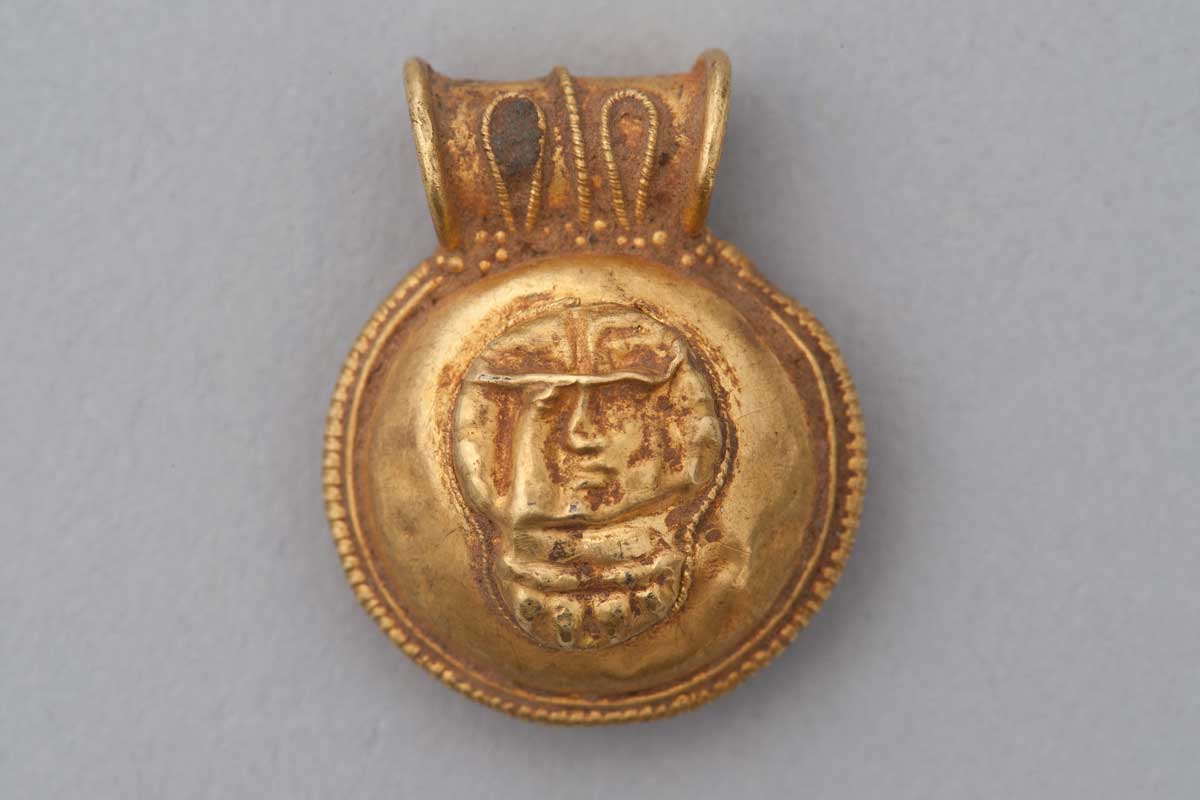Archaeology of Daily Life | Jewelry
Gold Bulla
By Jessica Phippen

Materials: Gold
Date/Culture: Etruscan or Roman
Find spot: Unknown
Condition: The object shows a Gorgon head in relief. The head wears a diadem, now somewhat distorted, as well as a necklace composed of four ovoid pendants. The front of the bulla is framed by crimped wire. The suspension loop has raised edges and is divided down the centre by twisted wire. On either side of the divider are petal-shaped compartments of twisted wire that were filled with stone or glass paste; the remnants of the paste remain on one side. The back of the bulla is dented and pierced in the centre. Raised dots separate the loop from the medallion on both the front and back of the piece.
Bullae were pendants worn by boys to ward off evil spirits and simultaneously proclaim their status as freeborn children. The Romans adopted the practice of wearing bullae from the Etruscans. Both cultures saw children as especially vulnerable and in need of protection. The gold bulla in the JHUAM may be either Etruscan or Roman in origin.
Ancient literary and visual sources attest to the Roman custom of decking young boys with bullae. Whether Roman girls wore bullae is still unclear. Bullae were also worn by Roman magistrates and victorious Roman generals (triumphatores). In Etruscan art, several deities are shown wearing a bulla. Gold bullae such as the one in the JHUAM would have been affordable only to members of the elite. Less expensive bullae were made of other materials, such as bronze and leather.
Freeborn Roman male children wore bullae until they reached adulthood. In ancient Rome, a boy would receive a bulla eight days after his birth on the same day that he was given his name. This important festival marked the child’s acceptance into the family. It is possible that Roman boys wore their bullae only when they were outside their homes, at occasions when they would have been in contact with people beyond their kin group. In addition to their bullae, Roman boys also wore the toga praetexta – a garment decorated with a broad purple stripe that was also worn by Roman magistrates. Together, the bulla and the toga praetexta visually declared a child’s status as a free Roman citizen.
The most striking feature of the JHUAM gold bulla is its relief of a gorgon’s head. In classical mythology, the gorgon was a female creature whose gaze could turn a person to stone. The term “gorgon” derives from the Greek word gorgos, which means “dreadful.” It typically refers to three sisters – Stheno, Euryale, and Medusa. Medusa, the most famous of the three, is said to have been slain by the mythical hero, Perseus. Images of the gorgon first appeared in Greek art in the 8th century B.C.E., making it one of the oldest figural representations in Western culture.
Because of its terrifying appearance and powerful gaze, the gorgoneion (i.e. the gorgon’s head or face) was thought to be a potent talisman capable of warding off evil spirits. The gorgoneion’s apotropaic function made it a common decorative motif in Greco-Roman antiquity, appearing on large public buildings, such as temples, and on a wide array of personal objects. Since bullae were protective amulets, the gorgoneion would have been an appropriate decoration for these pendants, offering extra protection to those who wore them.
References
Harlow 2002, 39-41, 67.
Haynes 2000, 282.
Huskinson 2007, 323-26, 336.
Rawson 2003, 26, 44, 50, 111, 144.
Warde Fowler 1896, 317-319.
Wilk 2000.